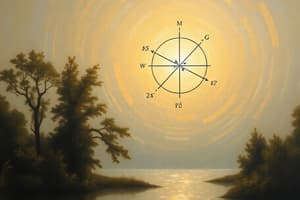Podcast
Questions and Answers
What is a characteristic of a major arc?
What is a characteristic of a major arc?
- It is larger than a semicircle. (correct)
- It is a diameter of the circle.
- It is exactly half of the circle.
- It is smaller than a semicircle.
How is a central angle defined?
How is a central angle defined?
- An angle whose vertex is on the circumference.
- An angle whose vertex is at the center of the circle. (correct)
- An angle formed by two chords intersecting inside the circle.
- An angle whose sides are tangent to the circle.
What does Circle Theorem 2 state regarding angles?
What does Circle Theorem 2 state regarding angles?
- The angle at the center is equal to the angle at the circumference.
- Angles in the same segment are supplementary.
- The angle at the circumference is three times the angle at the center.
- The angle at the center is twice the angle at the circumference. (correct)
What can be concluded about the angle in a semicircle according to Circle Theorem 4?
What can be concluded about the angle in a semicircle according to Circle Theorem 4?
What is the defining property of a secant line in relation to a circle?
What is the defining property of a secant line in relation to a circle?
According to Circle Theorem 5, what does the perpendicular from the center of a circle to a chord create?
According to Circle Theorem 5, what does the perpendicular from the center of a circle to a chord create?
What is the relationship between tangents that meet at the same point on a circle?
What is the relationship between tangents that meet at the same point on a circle?
Which of the following statements about cyclic quadrilaterals is true?
Which of the following statements about cyclic quadrilaterals is true?
What term describes a line segment from the center to any point on the circle?
What term describes a line segment from the center to any point on the circle?
Which formula can be used to calculate the circumference of a circle using the diameter?
Which formula can be used to calculate the circumference of a circle using the diameter?
If the radius of a circle is 5 cm, what is its circumference?
If the radius of a circle is 5 cm, what is its circumference?
In what situation would you use S = (θ/360)2πr to calculate arc length?
In what situation would you use S = (θ/360)2πr to calculate arc length?
What is the area of a sector of a circle with a radius of 3 cm and angle of 60 degrees?
What is the area of a sector of a circle with a radius of 3 cm and angle of 60 degrees?
Which of the following describes a minor arc?
Which of the following describes a minor arc?
How does an inscribed angle compare to a central angle that subtends the same arc?
How does an inscribed angle compare to a central angle that subtends the same arc?
What is the relationship between the radius and diameter of a circle?
What is the relationship between the radius and diameter of a circle?
Flashcards are hidden until you start studying
Study Notes
Circle Definition
- A circle is a closed shape formed by all points equidistant from a central point.
- Named by its center.
Circle Components
- Radius: Line segment from the center to any point on the circle.
- Chord: Line segment with endpoints on the circle.
- Diameter: A chord passing through the center.
Circumference
- Circumference of a circle is the distance around it.
- Another name for the perimeter of a circle.
- Formulas:
- C = 2πr (where r is the radius)
- C = πd (where d is the diameter)
- π = 3.14 (approximately)
Arc Length
- Arc length is the distance along the circumference of a circle or curve (arc).
- Formulas:
- S = θr (where θ is the angle in radians)
- S = (θ/360)2πr (where θ is the angle in degrees)
Sector Area
- The area enclosed within the boundary of a sector.
- Always originates from the center of the circle.
- Formulas:
- A = 1/2θr² (where θ is the angle in radians)
- A = (θ/360)(πr²) (where θ is the angle in degrees)
Arcs of a Circle
- Semicircle: An arc whose endpoints are the points of the diameter.
- Minor Arc: An arc smaller than a semicircle.
- Major Arc: An arc larger than a semicircle.
Angles of a Circle
- Central Angle: An angle whose vertex is the center of the circle.
- Inscribed Angle: An angle whose vertex is on the circle and whose sides contain chords of the circle.
Secant and Tangent
- Secant: A line that intersects the circle in two points.
- Tangent: A line lying on the same plane that intersects the circle in exactly one point.
- Point of Tangency: The point where the tangent touches the circle.
Circle Theorems
- Alternate Segment Theorem: The angle between a tangent and a chord is equal to the angle subtended by the same chord in the alternate segment.
- Angles at the Center and Circumference: The angle at the center is twice the angle at the circumference.
- Angles in the Same Segment: Angles in the same segment are equal.
- Angles in a Semicircle: The angle in a semicircle is 90 degrees.
- Chord of a Circle: The perpendicular from the center of a circle to a chord bisects the chord.
- Tangent of a Circle:
- The angle between a tangent and radius is 90 degrees.
- Tangents that meet at the same point are equal in length.
- Cyclic Quadrilateral: The opposite angles in a cyclic quadrilateral total 180 degrees.
Key Terminology
- Center: The central point of the circle.
- Radius: The distance from the center to any point on the circle.
- Chord: A line segment connecting two points on the circle.
- Diameter: The distance across the circle passing through the center.
- Circumference: The distance around the circle.
- Pi (π): The ratio of the circumference of a circle to its diameter.
Studying That Suits You
Use AI to generate personalized quizzes and flashcards to suit your learning preferences.




